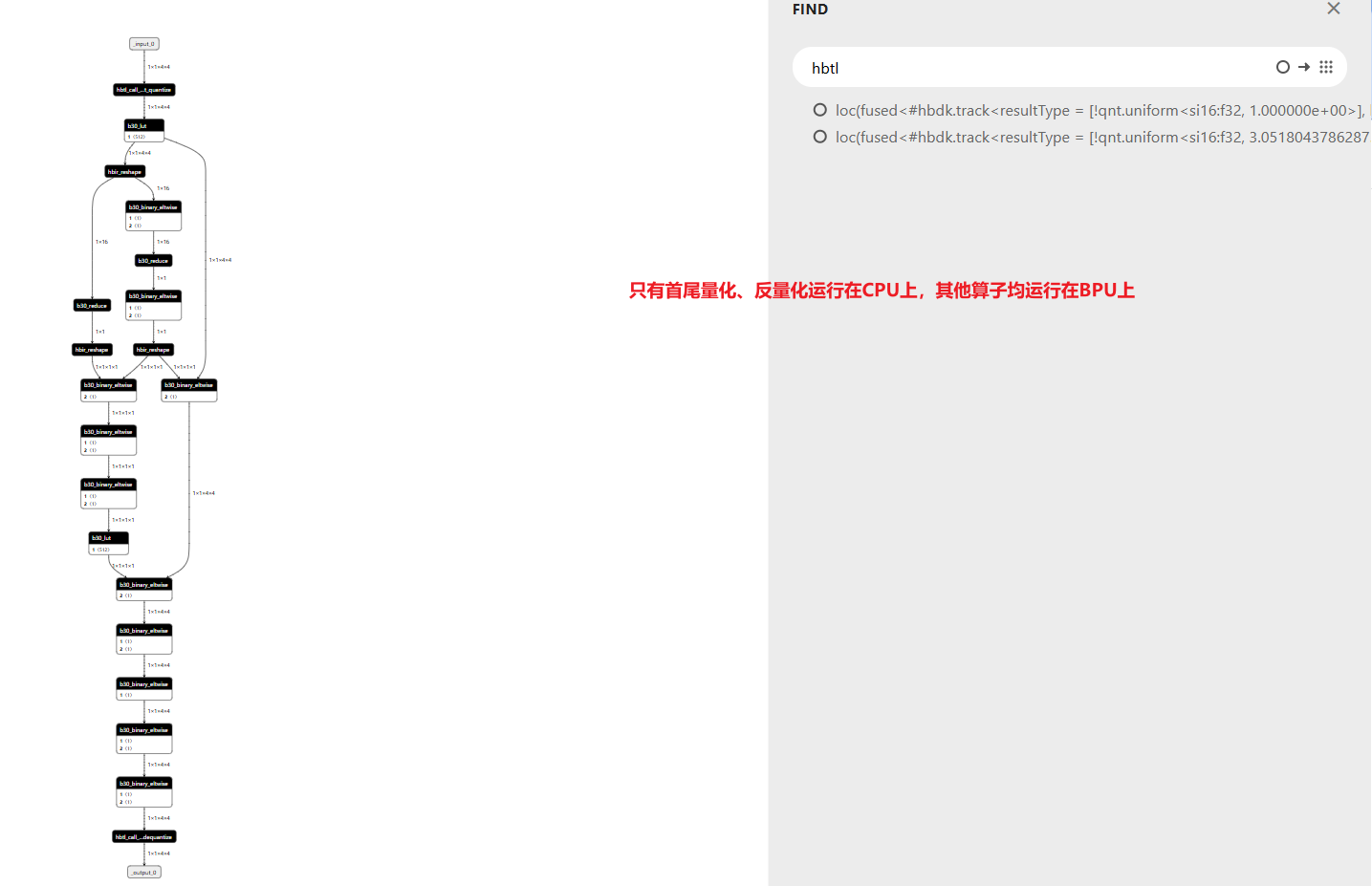征程 6 | 自定义查表算子实现量化部署
- 2025-08-14 广东
本文字数:4030 字
阅读完需:约 13 分钟

一、简介
模型部署时,常常面临模型精度与执行效率之间的权衡。查表(Look-Up Table, LUT)是一种在推理过程中用空间换时间的技巧,尤其适用于非线性映射函数的加速。本文将介绍如何在地平线平台上通过 SegmentLUT 实现一个自定义查表算子,并对它进行量化与导出。
本文以实现一个 DecInt 模块为例,将输入的 12bit 图像数据(值域为 [0, 4095]),通过自定义查找表进行非线性解码,模拟某种数值映射,然后进行归一化处理,最终输出一个 [-1, 1] 范围的结果图像。
查表算子常用于:实现数据非线性幅度调整、进行颜色空间的转换或者对比度的增强等场景。
二、SegmentLUT 模块
SegmentLUT 是地平线提供的用于查表操作的模块,具备以下特性:
支持将输入索引映射到查找表指定输出;
支持对 LUT 函数进行量化;
可导出为 HBIR,用于 BPU 编译执行。
from horizon_plugin_pytorch.nn import SegmentLUTclass SegmentLUT(Module): """ Simulate any elementwise function by: Segment Look Up Table for int16 input. Look Up Table for int8 input.
Args: simulated_func (Callable): Simulated function. is_centrosymmetric (bool): Whether F(x)=-F(-x). Deprecated. Use symmetric_mode instead. dividing_points (Optional[Union[List[Real], Tuple[Real]]]): Manually set the max input value of each segment. Defaults to None. input_range (Optional[Union[List[Real], Tuple[Real]]]): Manually set the valid input range. auto_divide_strategy (str): Strategy used to generate dividing points when dividing_points is None, only support 'evenly' and 'curvature'. inverse_func (Callable): The inverse function of the simulated function used to compute the input range in int-infer stage. !!!Note: Can only be used in monotonically decreasing function!!! Otherwise, the result of int-infer may be unexpected. Default to None gradients (Optional[Union[List[Real], Tuple[Real]]]): Manually set the gradient of linear interval on both side. symmetric_mode (str): It can be "ASYM", "YSYM" or "CSYM". Defaults to "ASYM". "ASYM": No symmetry. "YSYM": F(x)=F(-x). "CSYM": F(x)=-F(-x). """
三、构建查找表函数
定义一个将 [0, 4095] 映射到 [0, 16777215] 的函数。这里使用 numpy.interp 插值得到完整 4096 项的查表数组:
def get_dec_func(): # 样本点 # 代表的是位置索引 x = [0, 938, 1851, 2396, 3251, 4095] # 对应的是与x位置相对应的目标值 y = [0, 3132, 105740, 387380, 3818601, 16777215] # 插值构造查表表项(共 4096 项) lookup_table = np.interp(np.arange(4096), x, y).astype(np.int32) to_dec = torch.from_numpy(lookup_table).to(torch.float32)
def to_dec_func(x): indices = x.to(torch.int64) dec = torch.take(to_dec.to(x.device), indices) return dec return to_dec_func
通过这种方式,任意输入 [0, 4095] 的整数值,都可以在查表中获得对应的输出结果,实现近似非线性函数。
在这里,重点解释下
lookup_table = np.interp(np.arange(4096), x, y).astype(np.int32)
借助 np.interp 函数来完成线性插值工作,进而生成查找表
np.arange(4096)会生成从 0 到 4095 的整数序列,这些整数代表了查找表的索引。
np.interp(…)会在已知的点(x, y)之间进行线性插值,从而计算出每个索引所对应的插值结果。
.astype(np.int32)会把插值得到的浮点数结果转换为 32 位整数,这样做是为了符合查找表对整数的使用需求。
四、示例运行
示例很简单,主体包括:
为了方便部署,插入量化、反量化节点
调用 SegmentLUT 查表
数据归一化
class DecInt(nn.Module): def __init__(self): super(DecInt, self).__init__() to_dec_func = get_dec_func() self.to_dec = SegmentLUT(to_dec_func, is_centrosymmetric=True) self.sub = FloatFunctional() self.quant = QuantStub() self.dequant = DeQuantStub()
def forward(self, img): img = self.quant(img) img = self.to_dec(img)
# 找到每张图像的最大值与最小值 max_vals = img.view(img.size(0), -1).max(dim=1)[0].view(-1, 1, 1, 1) min_vals = img.view(img.size(0), -1).min(dim=1)[0].view(-1, 1, 1, 1) # 归一化到 [0, 1] diff = (max_vals - min_vals) + 1e-6 img = img - min_vals img = torch.clamp(img / diff, 0, 1.0) # 乘以 2,再减去 1,将其变换到 [-1, 1] 区间 img = img * 2 img = self.sub.sub(img, 1) return self.dequant(img)
全部示例代码:
from horizon_plugin_pytorch.nn import SegmentLUTfrom horizon_plugin_pytorch.nn.quantized import FloatFunctionalfrom horizon_plugin_pytorch.quantization import QuantStub, qint16from torch.quantization import DeQuantStubimport numpy as npimport torchimport copyimport torch.nn as nnfrom horizon_plugin_pytorch.quantization import QConfig, FakeQuantize, observer_v2from horizon_plugin_pytorch import set_march, Marchset_march(March.NASH_M)from horizon_plugin_pytorch.quantization import prepare, set_fake_quantize, FakeQuantState, FixedScaleObserver, FakeCastfrom horizon_plugin_pytorch.quantization import QuantStubfrom horizon_plugin_pytorch.quantization.hbdk4 import exportfrom horizon_plugin_pytorch.quantization.qconfig_template import calibration_8bit_weight_16bit_act_qconfig_setter, ModuleNameQconfigSetterfrom horizon_plugin_pytorch.quantization.qconfig import get_qconfig, MSEObserver, MinMaxObserverfrom horizon_plugin_pytorch.dtype import qint8, qint16from torch.quantization import DeQuantStubimport torch.nn as nnfrom horizon_plugin_pytorch.quantization import hbdk4 as hb4from hbdk4.compiler import convert, save, hbm_perf, visualize, compile
def get_dec_func(): # LUT 映射表:输入值 12bit范围 x = [0, 938, 1851, 2396, 3251, 4095] # 对应的输出值 y = [0, 3132, 105740, 387380, 3818601, 16777215] lookup_table = np.interp(np.arange(4096), list(x), list(y)).astype(np.int32) print(len(lookup_table)) exit() to_dec = torch.from_numpy(lookup_table).to(torch.float32) def to_dec_func(x): indices = x.to(torch.int64) dec = torch.take(to_dec.to(x.device), indices) return dec return to_dec_func
class DecInt(nn.Module): def __init__(self): super(DecInt, self).__init__() to_dec_func = get_dec_func() self.to_dec = SegmentLUT(to_dec_func, is_centrosymmetric=True) self.sub = FloatFunctional() self.quant = QuantStub() self.dequant = DeQuantStub()
def forward(self, img): img = self.quant(img) img = self.to_dec(img)
# 找到每张图像的最大值与最小值 max_vals = img.view(img.size(0), -1).max(dim=1)[0].view(-1, 1, 1, 1) min_vals = img.view(img.size(0), -1).min(dim=1)[0].view(-1, 1, 1, 1) # 归一化到 [0, 1] diff = (max_vals - min_vals) + 1e-6 img = img - min_vals img = torch.clamp(img / diff, 0, 1.0) # 乘以 2,再减去 1,将其变换到 [-1, 1] 区间 img = img * 2 img = self.sub.sub(img, 1) return self.dequant(img)
# 构造模拟输入数据:batch_size=1,单通道图像 4x4,值范围是0~4095(12bit)input_data = torch.randint(low=0, high=4096, size=(1, 1, 4, 4), dtype=torch.float32)
# 初始化模型model = DecInt()model.eval()
# 执行推理with torch.no_grad(): output = model(input_data)
print("输入图像:", input_data)print("输出:", output)
# A global march indicating the target hardware version must be setted before prepare qat.set_march(March.NASH_M)
calib_model = prepare(model.eval(), input_data, qconfig_setter=( calibration_8bit_weight_16bit_act_qconfig_setter, ), )
calib_model.eval()set_fake_quantize(calib_model, FakeQuantState.CALIBRATION)calib_model(input_data)
calib_model.eval() set_fake_quantize(calib_model, FakeQuantState.VALIDATION)calib_out = calib_model(input_data)print("calib输出数据:", calib_out)
qat_bc = export(calib_model, input_data)# save(qat_bc, "qat.bc")# visualize(qat_bc, "qat.onnx")hb_quantized_model = convert(qat_bc, March.NASH_M)# save(hb_quantized_model,"quantized.bc")# 可视化visualize(hb_quantized_model, "quantized.onnx")
验证运行在 BPU 上

地平线开发者
还未添加个人签名 2021-03-11 加入
还未添加个人简介










评论